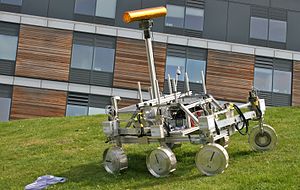ExoMars rover

ExoMars rover prototype, displayed at the 2009 U.K. Royal Astronomical Society National Annual Meeting
|
|||||
| Mission type | Mars rover | ||||
|---|---|---|---|---|---|
| Operator | ESA · RKA | ||||
| Website | exploration |
||||
| Mission duration | ≥ 6 months | ||||
| Spacecraft properties | |||||
| Manufacturer | Astrium · Airbus | ||||
| Launch mass | 310 kg (680 lb) | ||||
| Power | 1,200 W solar array/1142 W·h Lithium-ion | ||||
| Start of mission | |||||
| Launch date | July 2020 | ||||
| Rocket | Proton rocket | ||||
| Mars rover | |||||
|
|||||
The ExoMars rover is a planned robotic Mars rover, part of the international ExoMars programme led by the European Space Agency and the Russian Roscosmos State Corporation.
The plan calls for a Russian launch vehicle, an ESA carrier module and a Russian lander that will deploy the rover to Mars' surface, scheduled to launch in July 2020. Once safely landed, the solar powered rover would begin a six-month (218-sol) mission to search for the existence of past or present life on Mars. The ExoMars Trace Gas Orbiter, launched in 2016, will operate as the rover's data-relay satellite.
The rover is an autonomous six-wheeled terrain vehicle once designed to weigh up to 295 kg (650 lb), approximately 60% more than NASA's 2004 Mars Exploration Rovers Spirit and Opportunity, but about one third that of NASA's Curiosity rover launched in 2011.
In February 2012, following NASA's withdrawal, the ESA went back to previous designs for a smaller rover, once calculated to be 207 kg (456 lb). Instrumentation will consist of the exobiology laboratory suite, known as "Pasteur analytical laboratory" to look for signs of biomolecules or biosignatures from past or present life. Among other instruments, the rover will also carry a 2-metre (6 ft 7 in) sub-surface drill to pull up samples for its on-board laboratory.
The lead builder of the ExoMars rover, the British division of Airbus Defence and Space, began procuring critical components in March 2014. In December 2014, ESA member states approved the funding for the rover, to be sent on the second launch in 2018, but insufficient funds had already started to threaten a launch delay until 2020. The wheels and suspension system are paid by the Canadian Space Agency and are being manufactured by MDA Corporation in Canada.
...
Wikipedia
